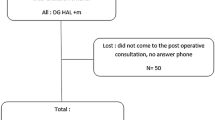Abstract
Background
Doppler-guided ligation of hemorrhoidal vessels is being proposed as a treatment of grade 2 and 3 hemorrhoids. Many researchers are coupling this procedure with mucopexy or lifting of hemorrhoids to control the prolapse more effectively. The present study was conducted in patients with 3rd-degree hemorrhoids to determine the usefulness of Doppler-guided hemorrhoidal artery ligation compared to mucopexy of prolapsing hemorrhoids and to compare it with mere mucopexy of the hemorrhoids.
Materials and methods
A double-blind, randomized controlled study was conducted on 48 consecutive patients with grade III hemorrhoids requiring surgery. The patients were randomized into two groups. Half of them were treated with ligation and mucopexy [SL], while the remaining patients underwent a Doppler-guided hemorrhoidal artery ligation followed by ligation and mucopexy [DSL]. The patients were examined by a blinded independent observer at 2, 4, and 6 weeks and at the end of 1 year after the operation to evaluate postoperative pain scores, amount of analgesics consumed, and complications encountered. The observer also assessed recurrence of hemorrhoids after 1 year.
Results
Operative time was significantly longer in the DSL group (31 min vs. 9 min P < 0.003). The postoperative pain score was significantly higher in the Doppler group [4.4 vs. 2.2, P < 0.002 (visual analogue scale)]. The mean total analgesic dose and duration of pain control using analgesics were greater and longer for the Doppler group than for the SL group (17 vs. 11 tablets, and 13 days vs. 9 days, respectively; P < 0. 01). Complications were similar in both the groups. At 1-year follow-up, the recurrence of hemorrhoids was not statistically significant in either group (4 patients in SL group and 3 patients in DSL group; P < 0.93).
Conclusions
Suture ligation of hemorrhoids is a simple, cost-effective, and convenient modality for treating grade 3 hemorrhoids. Doppler assistance in ligating the hemorrhoidal vessels prior to hemorrhoidal mucopexy offers no advantage and is a time-consuming procedure.


Similar content being viewed by others
References
Giordano P, Overton J, Madeddu F, Zaman S, Gravante G (2009) Transanal hemorrhoidal dearterialization: a systematic review. Dis Colon Rectum 52:1665–1671
Szmulowicz UM, Gurland B, Garofalo T, Zutshi M (2011) Doppler-guided hemorrhoidal artery ligation: The experience of a single institution. J Gastrointest Surg 15:803–808
Pol RA, van der Zwet WC, Hoornenborg D et al (2010) Results of 244 consecutive patients with hemorrhoids treated with Doppler-guided hemorrhoidal artery ligation. Dig Surg 27:279–284
Forrest NP, Mullerat J, Evans C, Middleton SB (2010) Doppler-guided haemorrhoidal artery ligation with recto anal repair: a new technique for the treatment of symptomatic haemorrhoids. Int J Colorectal Dis 25:1251–1256
Zagriadskiĭ EA, Gorelov SI (2008) Transanal doppler-guided hemorrhoidal artery ligation/recto anal repair (HAL-RAR®) for treatment of Grade 3–4 hemorrhoids: a new mini-invasive technology. Pelviperineology 27:151–155
Satzinger U, Fiel W, Glaser K (2009) Recto Anal Repair (RAR): a viable new treatment option for high-grade hemorrhoids. One year results of a prospective study. Pelviperineology 28:37–42
Theodoropoulos GE, Sevrisarianos N, Papaconstantinou J et al (2010) Doppler-guided haemorrhoidal artery ligation, rectoanal repair, sutured haemorrhoidopexy and minimal mucocutaneous excision for grades III-IV haemorrhoids: a multicenter prospective study of safety and efficacy. Colorectal Dis 12:125–134
Gupta PJ, Kalaskar S (2008) Ligation and mucopexy for prolapsing hemorrhoids—a ten year experience. Ann Surg Innov Res 2:5
Bruch HP, Roblick UJ (2001) Pathophysiology of hemorrhoids. Chirurg 72:656–659
Farag AE (1978) Pile suture: a new technique for the treatment of haemorrhoids. Br J Surg 65:293–295
Block IR (1985) Obliterative suture technique for internal hemorrhoidectomy. Dis Colon Rectum 28:679–680
Hussein AM (2001) Ligation-anopexy for treatment of advanced hemorrhoidal disease. Dis Colon Rectum 44:1887–1890
Serdev N (1990) The surgical treatment of hemorrhoids. Their suturing ligation without excision. Khirurgiia 43:65–68
Awojobi OA (1983) Modified pile suture in the outpatient treatment of hemorrhoids. A preliminary report. Dis Colon Rectum 26:95–97
Aigner F, Bodner G, Gruber H et al (2006) The vascular nature of hemorrhoids. J Gastrointest Surg 10:1044–1050
Schuurman JP, Go PM, Bleys RL (2009) Anatomical branches of the superior rectal artery in the distal rectum. Colorectal Dis 11:967–971
Scheyer M, Antonietti E, Rollinger G, Mall H, Arnold S (2006) Doppler-guided hemorrhoidal artery ligation. Am J Surg 191:89–93
Giamundo P, Cecchetti W, Esercizio L et al (2011) Doppler-guided hemorrhoidal laser procedure for the treatment of symptomatic hemorrhoids: experimental background and short-term clinical results of a new mini-invasive treatment. Surg Endosc 25:1369–1375
Giamundo P, Salfi R, Geraci M, Tibaldi L, Murru L, Valente M (2011) The hemorrhoid laser procedure technique versus rubber band ligation: a randomized trial comparing 2 mini-invasive treatments for second- and third-degree hemorrhoids. Dis Colon Rectum 54:693–698
Faucheron JL, Poncet G, Voirin D, Badic B, Gangner Y (2011) Doppler-guided hemorrhoidal artery ligation and rectoanal repair (HAL-RAR) for the treatment of grade IV hemorrhoids: long-term results in 100 consecutive patients. Dis Colon Rectum 54:226–231
Bronstein M, Issa N, Gutman M, Neufeld D (2008) Ligation under vision of haemorrhoidal cushions for therapy of bleeding haemorrhoids. Tech Coloproctol 12:119–122
Pakravan F, Helmes C, Baeten C (2009) Transanal open hemorrhoidopexy. Dis Colon Rectum 52:503–506
Tagariello C (2010) Manual hemorrhoidopexy in the treatment of hemorrhoidal disease. Updates Surg 63:45–50
Acknowledgments
Neither sponsorship nor financial support of any kind was received for the study.
Conflict of interest
No conflict of interest.
Author information
Authors and Affiliations
Corresponding author
Rights and permissions
About this article
Cite this article
Gupta, P.J., Kalaskar, S., Taori, S. et al. Doppler-guided hemorrhoidal artery ligation does not offer any advantage over suture ligation of grade 3 symptomatic hemorrhoids. Tech Coloproctol 15, 439–444 (2011). https://doi.org/10.1007/s10151-011-0780-7
Received:
Accepted:
Published:
Issue Date:
DOI: https://doi.org/10.1007/s10151-011-0780-7




